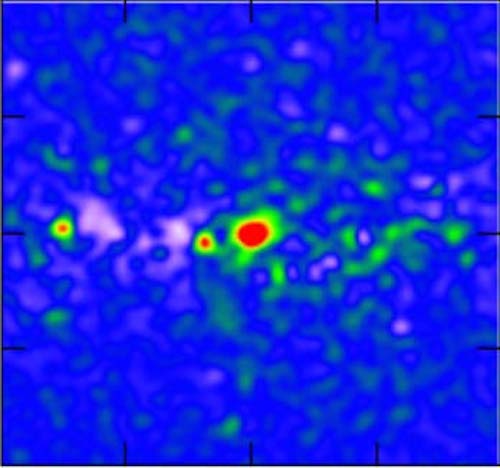.

A false-color image of the anomalous gamma-ray emission from the central region of the Milky Way galaxy; this emission is suspected of coming from dark matter annihilation. In this image, the emission from conventional sources has been subtracted from the total. The region covers roughly five degrees; the brightest emission is colored red and faintest blue. - See more at: https://www.cfa.harvard.edu/news/su201612#sthash.fSFTvDOa.dpuf
.
The Signature of Dark Matter Annihilation, Detected?
Science Update - A look at CfA discoveries from recent journals
We live in a dramatic epoch of astrophysics. Breakthrough discoveries like exoplanets, gravity waves from merging black holes, or cosmic acceleration seem to arrive every decade, or even more often. But perhaps no discovery was more unexpected, mysterious, and challenging to our grasp of the "known universe" than the recognition that the vast majority of matter in the universe cannot be directly seen. This matter is dubbed "dark matter," and its nature is unknown. According to the latest results from the Planck satellite, a mere 4.9% of the universe is made of ordinary matter (that is, matter composed of atoms or their constituents). The rest is dark matter, and it has been firmly detected via its gravitational influence on stars and other normal matter. Dark energy is a separate constituent.
Understanding this ubiquitous yet mysterious substance is a prime goal of modern astrophysics. Some astronomers have speculated that dark matter might have another property besides gravity in common with ordinary matter: It might come in two flavors, matter and anti-matter, that annihilate and emit high energy radiation when coming into contact. The leading class of particles in this category are called weakly interacting massive particles (WIMPS). If dark matter annihilation does occur, the range of options for the theoretical nature of dark matter would be considerably narrowed.
CfA astronomer Doug Finkbeiner and a team of colleagues claim to have identified just such a signature of dark matter annihilation. They studied the spatial distribution of gamma-ray emission in the Milky Way, in particular gamma-ray emission from the Galactic Center region. This region is both relatively nearby and has a high matter density (and nominally a high dark matter density as well). If dark matter annihilation occurred, the location would be expected to be bright in gamma-rays. Indeed, a large gamma-ray signature has been seen from the area that extends over hundreds of light-years (there is also fainter emission extending outward for thousands of light-years). There are other possible explanations, however, most notably that the gamma-rays result from a large population of rapidly spinning pulsars, the nuclear ashes of some supernovae.
The scientists revisited the set of previously published gamma-ray observations, applying careful new data reduction methods in order to constrain more precisely the location of the emission, and they did so for each of the several observed energy regimes of the gamma-ray emission. Pulsars have a distinctive spatial distribution: they are located where stars are found, predominantly in the plane of the galaxy. The team was able to show with high significance that the distribution of gamma-ray emission is in good agreement with the predictions of simple annihilating dark matter models, but less likely to be consistent with a pulsar explanation. Their result, if confirmed, would be an impressive breakthrough in the understanding of the nature of dark matter, the dominant constituent of the cosmos.
Reference(s):
"The Characterization of the Gamma-Ray Signal from the Central Milky Way: A Compelling Case for Annihilating Dark Matter," Tansu Daylan, Douglas P. Finkbeiner, Dan Hooper, Tim Linden, Stephen K. N. Portillo, Nicholas L. Rodd, and Tracy R. Slatyer, in Physics of the Dark Universe, Elsevier, 2016.
Quelle: HARVARD-SMITHSONIAN CENTER FOR ASTROPHYSICS
4589 Views
